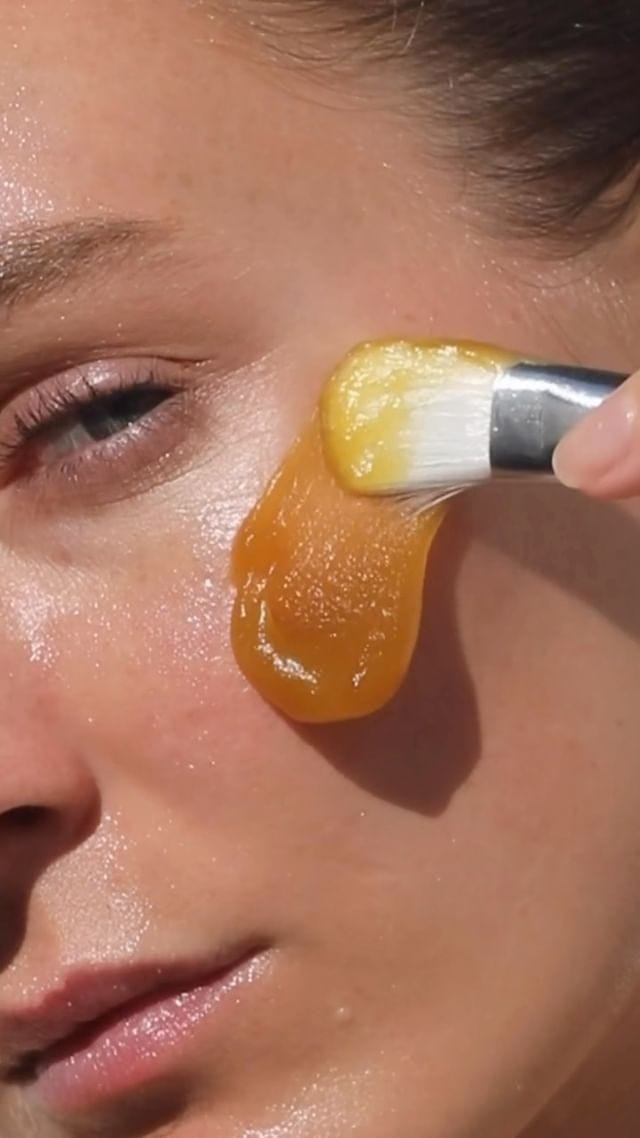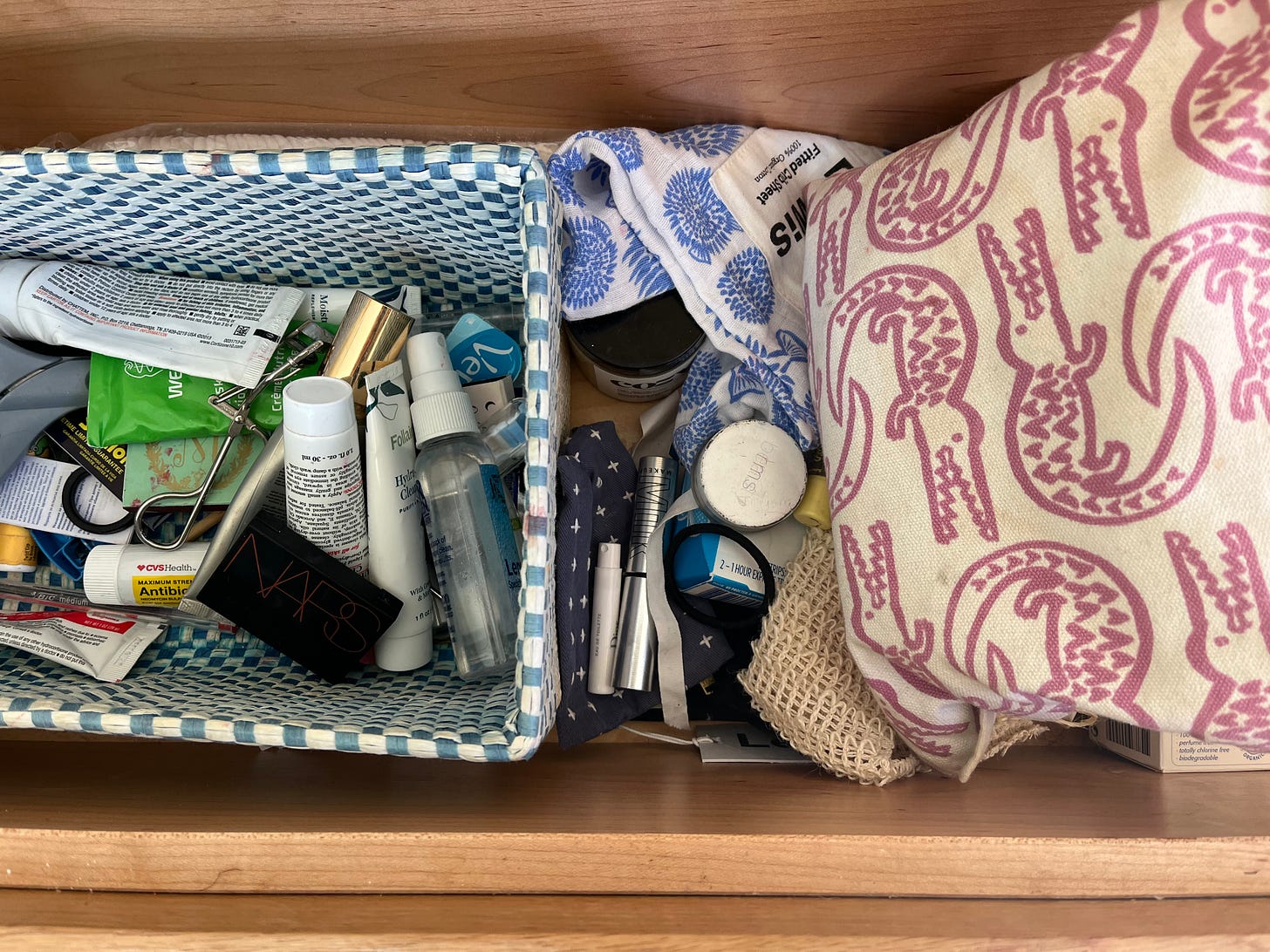I famously love a balm. I love a cream. I love an oil. Or more specifically, I love a beautifully shot ad featuring something goopy. As long as models and influencers and skincare gurus slowly rub viscous composites into their skin in slow-motion, I will watch, utterly rapt.
If you too find yourselves unable to look away when a hand model has her way with Glossier’s Cloud Paint, have you ever wondered why? If yes, it’s your lucky day. If no, I congratulate your brain on having better things to do.
When Jones Road first launched, an ad featuring Bobbi Brown slowly rubbing each shade of Miracle Balm onto her hand made its rounds on Instagram. I loved this ad. The unhurried way Brown displayed each color, the way she made each shade seem like it’s own particular brand of magic, and most of all the way the waxy balm melted into her skin. I posted about my obsession with this ad in my Instagram stories and was blown away by how many people responded saying that they too couldn’t tear their eyes away from a relatively long ad for . . . blush.
I thought about other creamy stuff I enjoyed watching throughout the years. Mr. Rogers visiting the crayon factory (iconic). Ina Garten creaming butter and sugar in a mixer. Joanna Gaines stirring a can of paint. Demi Moore playing with clay. Jauntily kicking off my Manolo Blahniks, and gazing pensively out the window, I couldn’t help but wonder, was my love for this Jones Road Miracle Balm ad connected to ASMR?
ASMR (Autonomous Sensory Meridan Response) is a fairly new phrase for what surely isn’t a new phenomenon. It was described in 2007 on an internet forum as “a weird sensation that feels good.” I’ve felt this sensation before (it’s triggered by something VERY unusual, which I’ll delve into for paid subscribers at the end of this essay). For me, it feels like being enveloped in warmth and stillness, with a faint, pleasant tingling sensation across the base of my skull. Some folks feel this sensation when watching someone dip their hands in wax and peel the dried wax off, some feel it when listening to the pages of a book being slowly turned, some feel it when watching a video of someone gently brushing someone else’s hair. And some people feel it when watching a model sumptuously apply hyaluronic acid serum to her decolletage.
ASMR has only been a serious topic of academic study since 2015, and brands have been employing ASMR in their marketing since 2016. While I don’t personally feel any ASMR tingles from the many skincare ads being hurled in my direction, I’m convinced that selling consumers on the promise of a skincare or beauty product (how it will transform your skin, your relationship, your life) is intrinsically connected to how marketers sell us on the materiality of the magical potion itself. When viewing images and videos of women with slim fingers and tapered nails luxuriously applying serums, lotions, and creams, we are invited to imagine the feel of the cream on our skin; we’re ushered into a sensory experience, and this makes the gap from voyeur to customer easier to bridge. We’ve felt the cream, we believe in the cream, we’ll buy the cream.
In an article for Glossy, Liz Flora reported that brands like Milk Makeup (I own their concealer), ColourPop, Tarte Cosmetics (I used to fuck around with their cheek tint) and Glow Recipe have posted TikTok videos hashtagged #ASMR since March 2020, and today, if you google almost any beauty brand along with the search term “#asmr,” you’ll find something like this.
In her B.A. thesis on ASMR and advertising, Andrea Rovira (who has over 260k subscribers on her ASMR Youtube channel), posits that ASMR does much more than merely elicit a feeling of calm when employed in skincare branding. ASMR paves the way for a viewer of an ad (or an Instagram reel) to feel an emotional connection to a product. In one study, Rovira reports that MRI brain scans showed that “ASMR videos generate tingling and relaxing sensations by the activation of brain regions previously observed during experiences like social bonding.” This makes sense! We use touch to cement intimate relationships, to make our loved ones feel safe, feel relaxed. I mean, these guys do too!
In this same study, the parts of the brain activated when a person experienced ASMR were the regions “associated with self-awareness, social cognition, and social behaviors including grooming.” When I view the below ad for True Botanicals Everyday Skin Tint, I immediately imagine the wet, slip of the serum against my skin, which is no longer my skin, but a smoother, more satiny version of my skin. For a quick moment I become the type of person who luxuriates in the application of makeup, which is no longer makeup but some sort of conduit to a more ethereal plane of existence. And this experience (and it is an experience) cements the product in my brain as something I’m familiar with, something I’m somehow intimate with despite never having physically interacted with.
Rovira explains that people most likely to be susceptible to ASMR are those who can be categorized as possessing a certain level of “openness to experience . . . People open to experience are generally curious about the world around them and may be prone to vivid fantasies or daydreams.” I’m sorry did someone say daydreams?!
ASMR also elicits chemical responses in the brain, hitting us with all the happy hormones, including dopamine, oxytocin, and endorphins, the exact hormones a brand would want to light up to make potential consumers feel good about parting ways with their money.
While the ultimate goal of advertising is obviously to increase sales, often the meta goal of individual ads or campaigns is to increase brand awareness, and to make would-be consumers feel a certain level of familiarity with or fondness for the brand. This is sometimes called relationship marketing. In the brick and mortar shopping experiences of ye olden days, of course, shoppers could foster a personal relationship with goods by stroking sweaters or holding brightly colored tees up against their faces. Maybe they wouldn’t buy those products in the moment, but they might very well remember the feel of the cashmere or remember the way the periwinkle blue of the tshirt made their eyes pop, leading to an eventual sale later on.
Of course, on Instagram, we can’t stroke sweaters or rub creams into the backs of our hands, but we can imagine doing these things, and researchers posit that an imaginary tactile experience might be just as ultimately effective as a literal tactile experience. Andrea Rovira cites scholars Joann Peck and Jennifer Wiggins in arguing that “Individuals who have the opportunity to touch an object feel a stronger sense of ownership, increasing their perception of its value. Interestingly, the degree to which individuals feel a sense of ownership is the same, whether they touch the object or merely close their eyes and imagine touching it.”
But here’s the thing - I don’t have to close my eyes or imagine touching whatever balm has captured my attention on a given Wednesday afternoon. The emotional buy-in occurs without me being particularly aware that it’s happening! And this is due to some ads’ intense focus on skincare products’ tactile reality. Rovira writes:
Researchers Elder and Krishna proved that when changing a product’s visual depiction for the viewers, they end up imagining an interaction with the product and increasing the purchase intention.
Look at this reel from Jones Road.
Within seconds, I’ve forgotten this is an ad for blush. Instead, I’m experiencing raw sensory pleasure. The shimmer looks pretty—and not pretty in a “this will highlight my jaw bone and make me look better to the the male gaze”—but pretty in the way that sparkles are pretty and stars are pretty. The manicured finger mushing deeply into the waxy surface of the blush is not remotely the way anyone would apply blush but it IS oddly satisfying! The motion of the thing that looks like a cake frosting spatula spackling the Jones Road balm against the wall like it’s caulking old nail holes is mesmerizing. The second shot of the cake frosting spatula smearing great gobs of Jones Road balm against a white surface makes me think of Bob Ross and his happy trees! Psychologically, I’m miles and miles away from unsettling thoughts of consumerism, climate change, the toxicity of beauty culture, and materialism. And that’s the point. If an ad makes me THINK about the act of accumulating yet another potion that won’t transform me from the inside out but will make my bank account smaller for largely futile, fucked up reasons, it’s not likely to be effective.
This type of marketing can work with still photos too. Look at the “almost whipped, velvety texture” of Glossier’s G Suit (a lip gloss).
The soft fuzz of the brush makes me think of a baby duck. The blob of gloss makes me think of brownie batter. I want it. I’m not thinking about why I want it. I’m not thinking about whether or not I already own similar glosses, or whether or not I even wear the ones I already own. I just feel cozy and sated with desire.
Watch this model absolutely DRENCH her skin with a medley of products - again - in a way that no actual person applies skincare products. Who among us lets serums drip down our already glistening cheeks like Disney raindrops?
While I’m only an expert on my own susceptibility to marketing, I do wonder if the current fetishization of creaminess will lead to a) fatigue, and b) ridicule. The model in the above reel is just TOO blissed out on serums to make me feel any sort of affinity for the brand, and this gloss exploding from the top of the tube makes me feel a little panicky, like when I pour a beer too quickly into a pint glass and the foam starts overflowing.
I’ll likely always enjoy watching Ina Garten rock some buttercream frosting, and guys if you haven’t watched the Mr. Rogers crayon factory tour, treat yourself and do it now, but my sensory enjoyment of such things has nothing to do with my conformance (or not) to beauty standards, my purchasing habits, or my sense of self. As with any marketing ploy designed to lead women to spend an inordinate time thinking about (and controlling) their bodies, the current trend of viscosity chic is meant to distract from choice. The choice to spend money. The choice to engage in beauty labor. The choice to equate face cream application with self-love.
Two months ago, I wrote about the hey girl hey branding of this balm, which yes, also engages with viscosity chic methodology! And while convincing a potential consumer that a fucking skincare product is a feminist ally is a different strategy from convincing a potential consumer that the mere creaminess of a product will be worth a $58.00 price tag, the goal is always the same. A little razzle dazzle by way of empty feminist solidarity, some smoke and mirrors by way of buttery texture. At the end of day I’m left with with nothing but a product encased in plastic sitting at the bottom of a drawer and another bout of unfilled desire waiting patiently to be triggered by the next ad.
Ok, and now for the totally weird thing that gives me ASMR tingles that I have yet represented on Tiktok, Youtube, or any other purveyors of ASMR videos.








